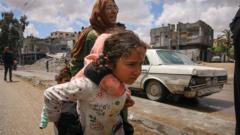12 minutes ago
About sharing
Watch: Celebrations in Gaza after Hamas says it accepts ceasefire deal
Israeli PM Benjamin Netanyahu has said a proposal for a new Gaza ceasefire is “far from Israel’s basic requirements” but negotiations will continue.
His comments came after Hamas said it had accepted the truce terms offered by Qatari and Egyptian mediators.
“The ball is now in Israel’s court,” an official in the Palestinian group said.
Overnight, Israeli forces and tanks were seen near the Rafah border crossing in southern Gaza, reports in Israeli media said.
Earlier, Israel’s military carried out air strikes on Rafah, on the border with Egypt, after warning Palestinians to evacuate eastern parts of the city.
Tens of thousands of residents are believed to be affected by the operation and many were seen cramming into vehicles or on to donkey carts on Monday.
Israel has long threatened an offensive against Hamas hold-outs in the city of 1.4 million people, many of whom have sought refuge there from Israeli offensives in other parts of Gaza.
Late on Monday, Mr Netanyahu’s office said in a statement: “Even though the Hamas proposal is far from Israel’s basic requirements, Israel will send a delegation of mediators to exhaust the possibility of reaching an agreement under conditions acceptable to Israel.”
At the same time, it added. Israel’s war cabinet had decided to continue the Rafah operation to “exert military pressure on Hamas to advance our war aims: the release of our hostages, destroy Hamas’s military and governing capabilities and ensure that Gaza does not pose a threat to Israel in the future”.
Earlier in the day, Hamas put out a statement saying its political leader, Ismail Haniyeh, had informed Qatar’s prime minister and Egypt’s intelligence chief of its “approval of their proposal regarding a ceasefire agreement”.
A senior Palestinian official familiar with the proposal told the BBC that Hamas had agreed to end “hostile activity forever” if the conditions were met.
That phrase hinted that Hamas might be contemplating the end of its armed struggle, although no further details were provided. It would come at the conclusion of a two-phase ceasefire deal, with each phase lasting 42 days.
The first phase would include the release of the female Israeli soldiers being held hostage, each in exchange for 50 Palestinian prisoners in Israeli jails, including some who are serving life sentences.
During this period, Israeli troops would remain within Gaza. But within 11 days of the ceasefire coming into force, Israel would begin dismantling its military facilities in the centre of the territory and would withdraw from Salah al-Din Road, which is the main north-south route, and the coastal road.
After 11 days, displaced Palestinians would be allowed to return to the north.
The second phase would conclude with a “sustainable long period of calm” and the complete lifting of the blockade of Gaza, according to the official.
Watch: Gazans ask ‘where will we go now?’ after Rafah evacuation orders
US state department spokesman Matthew Miller told reporters the US – which is attempting to broker a deal along with Qatar and Egypt – was reviewing Hamas’s response and “discussing it with our partners”.
The war began when Hamas gunmen stormed into southern Israel on 7 October, killing about 1,200 people and seizing more than 250 hostages.
More than 34,700 people have been killed in Gaza during the ensuing Israeli military campaign, according to the territory’s Hamas-run health ministry.
A deal agreed in November saw Hamas release 105 hostages in return for a week-long ceasefire and some 240 Palestinian prisoners in Israeli jails.
Israel says 128 hostages remain unaccounted for in Gaza, at least 34 of whom are presumed dead.
